You clever little beasts
From tool-making to language, new research shows
that animals share many of the attributes once believed to be uniquely
human By Windsor Chorlton
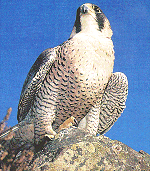 |
| Not just a dumb bird... Hob the
falcon "called his owner to help catch a pheasant |
Hob, a male falcon, is an excellent aerial hunter trained
by Paul Gillott, a police inspector based in Dorset. Hob is also smart. For
starters, he can recognise Paul's Lada car: one day, after becoming lost
in flight, he managed to spot Paul's vehicle on the A303. He followed it,
regardless of the heavy traffic, until Paul turned off onto a quiet road.
Another time, after chasing a pheasant into a hedgerow, Hob emerged on foot
and ran up to his trainer, vocalising in frustration. Ignoring the food he
was offered, he ran back into the hedge, still calling. He did this twice,
"Lassie-style", before Paul realised that Hob was actually demanding help,
and decided to follow him - across a ditch,over a fallen tree, and through
thick undergrowth, where he found the bird staring fiercely down a rabbit
hole at the tip of the pheasant's tail-feathers.
MEMORY |
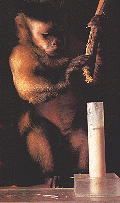 |
| Rhesus monkeys These animals can work
out how to use sticks to retrieve "unreachable" yoghurt from the bottom of
the tubes. In intelligence tests,rhesus monkeys tend to be more successful
than squirrel monkeys,marmosets,cats,rats and squirrels |
Comparative psychologists never attribute "intelligence" to an animal if
its actions can be explained by some simpler mental process. Applying this
rule, they would say Hob's keen eyesight was what enabled him to pick out
Paul's car. But acute sensory perception does not explain the incident with
the pheasant. Hob hasn't been trained to solicit help to catch prey, nor
is such behaviour innate in wild falcons.
The only reasonable interpretation is that Hob was demonstrating what we
would call intelligence - that is, using innovative behaviour to solve a
problem. Many scientists shudder at the suggestion of animal intelligence.
Despite our evolutionary link with other species, they still believe that
we stand on one side of an intellectual divide, while on the other, animals
blunder about like some kind of automata, driven only by blind instinct or
environmental conditioning.
Bit by bit, though, this gulf is being bridged as researchers discover that
animals display many "human" attributes. One measure of intelligence is speed
of learning, and despite the difficulties of devising a test applicable to
animals with different sensory equipment, psychologists have made valid
distinctions between the learning speed of different species.
In one test involving six different species, rhesus monkeys came out top
followed by squirrel monkeys, marmosets, cats, rats and then squirrels. This
order tends to confirm the theory that brain power increases the higher the
animal's ranking on the phylogenetic scale - which places primates and monkeys
above the other mammals, which in turn are higher on the scale than birds,
reptiles and fish.In fact millions of years of parallel evolution have given
certain carnivores larger brains than some monkeys, whereas there is considerable
overlap in the brain - size of birds and small mammals.
|
Who are you calling a bird brain?
Among birds, crows have especially large forebrains and display impressive
resourcefulness Faced with the problem of how to transport scattered biscuits,
ravens, unlike other birds, don't carry them off one-by- one. They stack
them into one neat pile, and then carry them all off .
The woodpecker finch of the Galapagos Islands uses a cactus spine to prise
insects out of crevices, while the Egyptian vulture smashes open ostrich
eggs with stone.
TOOL USE |
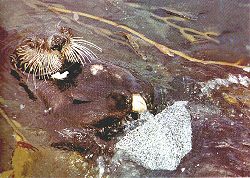 |
| Sea otters use stones to open tasty shell fish. A hungry
otter is capable of cracking 50 mussels in 90 minutes - delivering more than
2,000 blows in the process |
Surprisingly, the only non-primate mammal known to use stone tools is the
sea otter. It used to be thought that animals used tools for immediate tasks
only, and then discarded them; but sea otters retain favourite stones, tucking
them into their armpits when they dive for food.
In what is now Ghana, colonial forestry official W B Collins witnessed the
extraordinary way in which driver ants harnessed a simple tool to break through
the defences of a horde of snails. Driver ants can reduce a python to bones
in an hour, but these snails initially repelled the ant army by secreting
a foam-like mucus into the entrances of their shells for protection.
The ants deposited crumbs of dry soil in
the mucus. As the liquid was absorbed, the snails responded by secreting
yet more mucus, and in turn, the ants deposited more soil around the snails.
This relentless attack technique was repeated until the snails had exhausted
their mucus reserves and lay defenceless.
Tools of the trade
Tool-making by animals was first recorded in the 1960s by primatologist
Jane Goodall, who observed chimpanzees stripping
leaves off branches to fashion probes for fishing termites out of their nests
In captivity,chimps display even greater ingenuity, wielding sticks to rake
in food from outside their enclosure and stacking boxes in order to reach
bananas hung high in their cage.
Impressed by feats like these, American psychologist
Sue Savage-Rumbaugh and archaeologist Nick
Toth mounted a project to see whether a chimpanzee could use one tool to
make another - the breakthrough that launched early man's technological leap
forward. As their apprentice, they chose a chimp called Kanzi.
First, they showed Kanzi how to produce stone chips by striking one cobble
against another, then they demonstrated how the flake could be used as a
tool to cut the string securing the lid of a food box. After that, Kanzi
was left to his own devices. His efforts weren't particularly impressive,
and, after a four-month period, he decided to try a new technique - hurling
the stone at the concrete floor and smashing it to fragments.
LEARNING CURVES |
 |
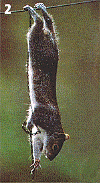 |
| After three weeks of trial and error,this squirrel figured
out how to open a "squirrel proof" bird feeder. Intelligence coupled with
daring acrobatics got the results |
Reluctantly deciding that this wasn't the method used by
early man, the researchers covered the floor
with carpet, but within minutes Kanzi pulled back the carpet and again threw
the stone against the concrete. Finally, he was turned out into an earth
enclosure and this time he placed a rock on the ground, took aim with the
hammer-stone and let fly. His handiwork may not have been up to the standards
achieved by early man but he certainly learnt how to break rocks.
Those Machiavellian manoeuvres
Since chimpanzees are our closest
animal relatives, sharing 99 per cent of
our genes, it's not surprising that much of their behaviour resembles our
own. The Greek philosopher Aristotle claimed that man was the only political
animal, but at Arnhem Zoo in Holland, Frans de Waal found that his male
chimpanzees were positively Machiavellian, forming shifting alliances in
a struggle to gain access to females.
These group power struggles sometimes ended in death, and it was not always
the strongest that triumphed. As de Waal explains: "The weakest of the three
competing parties gain more by joining forces and sharing the spoils than
by joining the strongest party, who then end up monopolising the pay-offs"
Animal philosophy through the ages
|
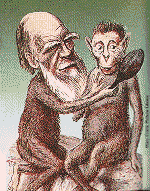
Soulful creatures
13th century Italian philosopher St Thomas
Aquinas believed that all creatures and plants possess souls.
Deus ex machina
17th century French philosopher mathematician and devout Catholic
René
Descartes believed humans to be set apart from the rest of creation.He
viewed animals as unthinking machines, lacking conscious perception, but
with God-given instinct.
Abstract Limits
17th century English philosopher and scientist John Locke held the
opinion that animals have perception, memory and reason but not the ability
for abstract thought.
A sliding scale of reason
In the Descent of Man, he argued that "animals possess some power
of reasoning" and that "the difference in mind between man and higher animals,
great as it is, certainly is one of degree and not kind" Darwin's concept
of instinct was similar to Descartes', with evolution replacing the work
of God.
Definite George
George Romanes, a disciple of Darwin, wrote Animal Intelligence in
1882, the first attempt at scientific analysis of animal intelligence. He
defined intelligence as "the capacity to adjust behaviour in accordance with
changing conditions".
Reflex action
20th century Russian biologist Pavlov was the first scientist to make a
scientific study of learning. He performed experiments in which dogs learnt
to associate the sound of a bell with food. Pavlov termed this response as
"conditioned reflex".
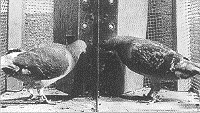 |
BF Skinner devised aptitude experiments for
pigeons in order to show their learning capacity
|
Skinner's rewards
BF Skinner, one of most influential figures in learning theory and author
of The Behaviour of Organisms, conducted experiments in trial-and-
error learning used "Skinner boxes" which yield a food reward if the animal
pushes the correct sequence of buttons.
Songs to learn
Biologist WHO Thorpe reared chaffinches in isolation to prove that their
song development is not instinctual. They learn song from older birds.
The mental map
Twentieth century American psychologist Edward Tolman noted that the behaviour
of most animals suggests sophisticated navigation. He argued that all animals
have a "cognitive map" and some sense of direction.
The beginnings of Ethology
Niko Tinbergen and Konrad Lorenz
are regarded as the founders of modern ethology (the science of animal
behaviour). Their scientific system is still used by ethologists today.
Researched instinct, learning and imprinting and won a Nobel prize in 1973.
Tool use
Primatologist Jane Goodall made ground-breaking discoveries in the 1960s
with her studies of wild chimpanzees. She was the first to observe the
chimpanzee's ingenious use of tools.
Dancing Bees
Zoologist Karl von Frish's discovered the bee language system, whereby the
scout bees perform a sophisticated "dance" routine to communicate information
to the rest of the hive about the exact location of new food sources. He
shared the Nobel prize with Tinbergen and Lorenz in 1973.
 |
| A chimp and human communicate by touching
symbols on a keyboard |
Termite Society
Biologist Edward Wilson studied social organisation in animal groups -
particularly highly complex termite societies. He wrote the influential
book, Sociobiology.
Animal suffering
Oxford zoologist Marian Dawkins wrote Animal
Suffering. Her controversial work with hens showed that they prefer outdoor
conditions to living in battery cages - and on release ,hens exhibit some
of the same emotional responses as humans released from prison.
Definite William
William Hodos studied animal intelligence in relation to neuroanatomy. He
said: "We must accept a more general definition of intelligence than one
closely tied to human needs and values."
Do animals have consciousness?
Harvard biologist Donald Griffin is one of the leading scientists to advocate
animal consciousness. In his book, Animal Thinking, he argues that
"it is difficult to accept that mind and consciousness in humans have just
arisen without any precursors in animals that were ancestral to us and probably
very similar to the non-human primates that we observe now."
|
Deception seems to be a conscious strategy of apes, as Keith Lloyd, a primate
expert at London Zoo, discovered when he was duped by a gorilla - a dominant
silverback in a group where one of the females had given birth to a baby
fathered by another male. Because infanticide by jealous male primates is
not unusual, Lloyd carefully monitored the body language of the silverback
to see whether he was hostile to the new arrival. All his gestures indicated
he wasn't, so Lloyd left the group alone for a time and returned to find
that the old silverback had killed the baby. "I'm sure he intended to lull
me into sense of false security," says Lloyd, "fully intending to kill the
baby as soon as I left."
To Harvard biologist Donald Griffin, the capacity of animals to deceive suggests
that they have consciousness;they think out the best strategy and communication
to produce the intended response.
MIMICRY |
When Robert Gross was photographing a kingfisher, he
noticed a robin always turned up, seemingly to observe the kingfisher's
technique. The robin soon attempted fishing for itself - gradually refining
its fishing technique over several months
|
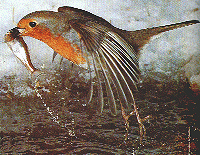 |
Animals say hello
Evidence of intentional communication comes from research on wild vervet
monkeys in Kenya. These monkeys utter three distinct alarm calls in response
to different predators, and the other troop members respond appropriately:
climbing into treetops at the leopard alarm; diving into undergrowth at the
eagle call; and standing upright in a search posture for the snake warning.
Slight variations in the signals among different vervet troops suggest that
the calls are culturally transmitted.
In a comprehension test of 660 sentences, chimp Kanzi scored better than
a two and a half year-old child
This looks uncannily like a proper language, mankind's crowning glory - the
gift many scientists are most reluctant to admit that we share with other
species. Linguists such as the influential Noam Chomsky assert that human
language has no discernible evolutionary connection with any other form of
animal communication. For one thing, animals can't communicate abstract concepts.
Or can they?
DEXTERITY |
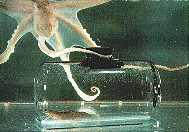 |
They may not have a backbone, but they do have brains
The octopus is the most intelligent
invertebrate. In this sequence, an octopus quickly figures out how the cork
in the bottle has to be removed in order to retrieve the shrimp inside
|
Try telling that to Alex,an African grey parrot trained by
Irene Pepperberg of the North-western University
in Illinois. Alex can discriminate between 80 different objects arid classify
them according to shape, colour or material.
Mere mimicry and robotic conditioning,
scoff the sceptics, who insist that
the essential ingredient of rational language is syntax - the structural
system to order words in meaningful ways. Yet the songs of whales contain
syntax-like elements, and dolphins studied
by Louis Herman in Hawaii understand commands made up of the same words ordered
differently. For example, they know the difference between "Bring frisbee
to surfboard" and "Bring surfboard to frisbee".
Most animal language studies have concentrated on chimpanzees which, as our
nearest relatives, might be expected to possess some of the elements of true
language. Cognitive scientist Steven
Pinker disagrees, arguing that primate language is controlled
by a part of the brain that in humans produces emotional utterances such
as laughter, and the kind of involuntary oaths we utter when we suffer
pain.
It's true that primates can't speak, but that's because they lack the vocal
and neurological apparatus, says Sue Savage-Rumbaugh, who has taught chimpanzees
to communicate through lexigrams - geometrical symbols arranged on a keyboard.
Kanzi, the apprentice tool-maker chimp, spontaneously learned the meanings
of some lexigrams and by the age of seven he could comprehend about 200.
His understanding of spoken language is so good that, in a comprehension
test of 660 sentences, he scored better than a two and a half year-old human
child. Findings like these may force us to reconsider the way we treat "dumb"
animals. It seems that the more we delve into their minds, the more we find
that we are different only in degree, not kind.
INDEX
 Sep96 p92
Sep96 p92









